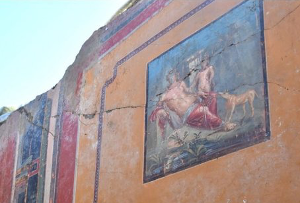|
Narcissus Fresco Found in Pompeii House
February 18, 2019
Archaeologists in Pompeii have found a fresco detailing the famous Greek mythological figure Narcissus, who fell in love with his own reflection. The fresco is in the same house where another fresco, depicting the myth of Leda and the Swan, was recently unearthed. Both works survived the deadly eruption of Mount Vesuvius that ravaged the town of Pompeii in 79 A.D. The fresco shows the hunter relaxing by a pool, his face captivated by what he sees there. A nearby dog is tugging at the hunger's clothing, trying to divert his attention. The Narcissus fresco is in the atrium, a part of the house that the owners of the home would have used to conduct business. Also found in the home were the remains of some stairs and fragments of glass containers and a handful of amphorae. In the myth, Narcissus is some good-looking that he is adored by all. He hears a prediction about himself: that he will live a long life as long as he never sees himself. He spurns the lovely Echo, who has fallen in love with him and who, heartbroken, retreats to a cave, where eventually all that is left is a voice. The actions of Narcissus regarding Echo anger the god Nemesis, who arranges for Narcissus to see his own reflection in a pool; Narcissus is transfixed and hopelessly in love. He wastes away with his love unfulfilled because he cannot touch the object of his love. Both Echo and Narcissus have lent themselves to modern words. The newly discovered fresco depicts Narcissus but not Echo, presumably because the scene that the fresco depicts takes place after Narcissus's rejection of Echo. |
Social Studies for Kids |
Social Studies for Kids
copyright 2002–2024
David White





